Метопы Парфенона - Metopes of the Parthenon - Wikipedia
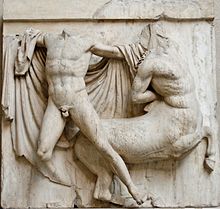
В метопы Парфенона представляют собой сохранившийся набор из 92 квадратных резных бляшек из пентелийского мрамора, первоначально расположенных над колоннами Парфенон перистиль на Акрополь Афин. Если их делали несколько художников, мастер-строитель обязательно Фидий. Они были вырезаны между 447 или 446 годом до нашей эры. или самое позднее 438 г. до н.э., с 442 г. до н.э. как вероятная дата завершения. Большинство из них сильно повреждены. Обычно они представляют собой двух персонажей на метоп в действии или в состоянии покоя.
Интерпретации этих метопы являются лишь догадками, начиная с простых силуэтов фигур, иногда едва различимых, и сравнивая их с другими современными изображениями (в основном вазами). На каждой стороне здания есть одна тема, каждый раз представляющая битву: Амазономахия на Западе, падение Трои на севере, гигантомахия на востоке и битва Кентавры и Лапифы на юге. Метопы имеют чисто воинственную тематику, как и украшение хризелефантин статуя Афина Парфенос разместился в Парфеноне. Похоже, это пробуждение противостояния между порядком и хаосом, между человеком и животным (иногда животные склонности в человеке), между цивилизацией и варварством, даже между Западом и Востоком. Эта общая тема считается метафорой Срединные войны и, таким образом, торжество города Афины.
Большинство метопов систематически разрушен христианами во время преобразования Парфенона в церковь в шестом или седьмом веке нашей эры. Пороховой магазин установлен в здании у Османы взорвался во время осады Афин венецианцами в сентябре 1687 года, продолжая разрушение. Лучше всего сохранились южные метопы. Четырнадцать из них находятся в британский музей в Лондоне, а один в Лувр С другой стороны, сильно поврежденные, находятся в Афинах, иногда даже все еще на месте.
Парфенон

1)Пронаос (Восточная сторона)
2) Naos Гекатомпедон (восточная сторона)
3) Статуя хризелефантин из Афина Парфенос
4) Парфенон (сокровищница) (западная сторона)
5) Опистодомос (Западная часть)
В 480 г. до н.э. персы разграбили Афинский Акрополь, включая "пред-Парфенон "тогда строится.[1][2][3] После их побед на Саламин и Платеи Афиняне поклялись не восстанавливать разрушенные храмы, а оставить их такими, какие они есть, в память о персидском «варварстве».[2][3]
Затем власть Афин постепенно росла, в основном в лига Делоса который он контролировал все более и более гегемонистски. В конце концов, в 454 г. до н.э., сокровища союза были перенесены из Делос в Афины. Затем была начата обширная программа строительства, финансируемая за счет этого сокровища; среди них Парфенон.[4][5] Это новое здание не предназначалось для того, чтобы стать храмом, а было сокровищницей для размещения колоссальной хризелефантовой статуи Афины Парфенос.
Парфенон был возведен между 447 и 438 годами до нашей эры.[1] «Предпарфенон» (малоизвестный) был гексастиль. Его преемник, который был намного больше, был октастиль (восемь столбиков спереди и семнадцать по бокам перистиля)[6] и имел размеры 30,88 метра в ширину и 69,50 метра в длину.[1] Сам секос (замкнутая часть, окруженная перистилем) имел ширину 19 метров.[7] Таким образом, можно было создать две большие комнаты: одну, на востоке, для статуи высотой в десяток метров; другой - на запад, чтобы спрятать сокровища Лиги Делоса.[1][7] Строительную площадку доверили Иктинос, Калликрат и Фидий Проект декора был традиционным по форме (фронтоны и метопы), но беспрецедентным по масштабу. Фронтоны были крупнее и сложнее, чем раньше. Число метопов (92), все вырезанные, было беспрецедентным и никогда не повторялось. Наконец, в то время как храм был Дорический орден, украшение вокруг секоса (обычно состоит из метопов и триглифы ) был заменен фризом ионный порядок.[8][9][10]
Общее описание
Общая структура
На дорический мраморные здания, метопы украсил антаблемент выше архитрав чередующийся с триглифы . Это напоминало деревянные балки, поддерживающие крышу. Часть между триглифами, сначала простое неукрашенное каменное пространство, быстро использовалась для создания резного украшения.[11]
Парфенон насчитывал девяносто два полихромных метопа: по четырнадцать на восточном и западном фасадах и по тридцать два на северной и южной сторонах. Чтобы обозначить их, ученые обычно нумеруют их слева направо римскими цифрами.[12] Они были вырезаны на практически квадратных плитах из пентелийского мрамора: высота 1,20 метра для переменной ширины, но в среднем 1,25 метра. Первоначально мраморный блок имел толщину 35 сантиметров: скульптуры были выполнены с высоким рельефом, даже с очень высоким рельефом по краю круглой выпуклости, выступающей примерно на 25 сантиметров.[13][14][15][16][17][18] Метопы были высотой в дюжину метров и имели в среднем по два символа на каждом.[19]
Ни одно древнегреческое здание никогда не украшалось таким количеством метопов, ни до, ни после постройки Парфенона. На Храм Зевса в Олимпии, которая предшествовала Парфенону, были вырезаны только те, что на внутреннем крыльце; на Храм Гефеста, современные ему, вырезаны только те, что на восточном фасаде, и последние четыре (на восток) с северной и южной сторон.[19]
Темы и интерпретации
Нет древних описаний метопов, которые могли бы дать окончательную интерпретацию. Первое литературное воспоминание о резном убранстве Парфенона было написано Павсаний во втором веке нашей эры .; однако он описывает только фронтоны.[20][21] Тем не менее, сравнение с темами современной аттической керамики может предложить возможные интерпретации.[20]
Общая тема девяноста двух метопов носит чисто воинственный характер, как и в случае с хризэлефантовой статуей Афины. [N 1] но в отличие от фронтонов и фриза. Кажется, что это противостояние между порядком и хаосом, между человеком и животным (иногда между различными животными тенденциями в человеке), между цивилизацией и варварством, даже между Западом и Востоком. Все это часто рассматривается как метафора персидской войны.[19][22][23][24] Основной темой может быть брак и тот факт, что нарушение его гармонии ведет к хаосу.[N 2] С этого момента, как и повсюду на Парфеноне, будет прославляться гражданские ценности, в основе которых лежит брак между гражданами и дочерьми граждан.[25]
Метопы на восточной, северной и западной сторонах в основном пострадали от систематического разрушения христианами примерно в шестом или седьмом веке: поэтому трудно точно знать, что они представляли. На востоке, наиболее важной с религиозной точки зрения стороной, темой метопов была бы гигантомахия. Зевс и Гера (или же Афина ) будут представлены на центральных метопах, а бои будут организованы симметрично вокруг них. На западе они изображали греков, сражающихся с противниками в восточных костюмах. Наиболее распространенное толкование - это амазономахия; однако метопы получили такие повреждения, что теперь трудно определить, являются ли противники греков мужчинами или женщинами. Если бы это были люди, то они могли бы быть персами; однако есть несколько изображений персов верхом на лошади. Во время осады Афин венецианцами Франческо Морозини В 1687 году метопы на северной стороне были сильно повреждены взрывом порохового запаса, размещенного в Парфеноне. Однако были предложены отождествления: один из метопов будет представлять Менелай и его сосед Хелен; другой Эней и Анхисы. Таким образом, главной темой этой стороны могло быть падение Трои.[19][22][23][16][26] Наконец, южные метопы не пострадали от христианской иконоборчество, но пострадал от взрыва 1687 года. Последние оставшиеся, расположенные на каждом конце Парфенона, представляют битву кентавров и лапифов, но центральные метопы известны только по рисункам, приписываемым Жак Керри вызывают разногласия по поводу интерпретации. Некоторые археологи считают, что это могла быть чисто афинская битва между людьми и кентаврами.[19][16][27]
Скульптура и живопись
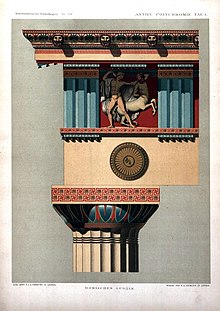
Метопы Парфенона были вырезаны в несколько этапов. Художник начал с рисования контуров своих персонажей; затем он удалил мрамор за пределы рисунка, в «низ» метопа; он продолжал отделять фигуру от дна; он закончил, улучшив самих персонажей. Возможно, что несколько скульпторов, каждый из которых специализировался на одном из этих этапов, могли сотрудничать.[28] Скульптуры должны были быть выполнены на земле, прежде чем были установлены метопы, на вершине стен. Скульпторы, которых должно было быть много, наверняка начали работать с 447 или 446 г. до н.э., чтобы завершить свою работу до 438 г. до н.э., когда началась работа над кровлей; 442 г. до н.э. или вскоре после этого - вероятная дата завершения. Более того, если резное украшение нужно было закончить, то это было не то же самое, что и роспись или металлические украшения, которые можно было добавить позже.[19][29] Некоторые художники могли работать над несколькими метопами. Таким образом, для метопа к востоку VI Посейдон находится в том же положении, что и Лапиф на южном метопе II, в то время как падающий гигант находится очень близко к Лапифу на южном метопе VIII, что может означать, что они принадлежат одной руке; разве что только вдохновение и подражание.[30]
Имя скульптора не сохранилось. Однако, поскольку метопы сильно различаются по качеству и стилю, весьма вероятно, что они были изготовлены несколькими руками. Некоторые из них кажутся «старыми», кажется, из-за более старых или более консервативных художников; но их тоже можно было сделать первыми. Те, чье качество не на уровне других, также предполагают, что, учитывая размер участка, необходимо было задействовать всех имеющихся скульпторов. Последняя гипотеза синтезирует все остальные: в начале строительства было нанято много художников; но по мере продвижения работы некомпетентные специалисты постепенно отбрасывались, не без того, чтобы уже были изготовлены первые метопы более низкого качества.[31][32][28][16] Некоторые южные метопы имеют такое качество, что был сделан вывод, что они, должно быть, были вырезаны среди последних;[N 3] в некоторых случаях имена скульпторов вроде Майрон, Алькаменес или сам Фидий.[33] Роберт Спенсер Станье предложил в 1953 году оценку общей стоимости реализации метопов в 10 талантов.[34]
Метопы Парфенона, как и все остальные декорации, были полихромными. Фон был определенно красным, в отличие от триглифов среднего или темно-синего цвета. Карниз над метопом тоже пришлось раскрасить. Персонажи были нарисованы, с поднятыми глазами, волосами, губами, драгоценностями и драпировками. Кожа мужских фигур должна была быть темнее кожи женских персонажей. Некоторые метопы [N 4] включены элементы ландшафта, возможно, тоже нарисованные. Декор был завершен добавлением элементов (оружия, колес или сбруи) из бронзы или позолоченной бронзы, о чем свидетельствуют многочисленные крепежные отверстия: на южных метопах их более 120, наиболее сохранившихся. Эти декоративные элементы также можно использовать для более быстрой идентификации персонажей.[35][17] Между объектами метопов и хризелефантовой статуей Афины, сохранившейся в Парфеноне, существует очень тесная связь. Это могло означать, что Фидий был главным подрядчиком строительства.[19][10]
История и сохранение

Парфенон был разрушен пожаром в неустановленную дату в период поздней античности, в результате чего был нанесен серьезный ущерб, включая разрушение крыши. Сильный жар расколол многие мраморные элементы, включая антаблементы и, следовательно, метопы. Была проведена обширная реставрация: переделана крыша, но покрыта только внутренняя часть; Поэтому метопы (передняя и задняя поверхности) были более подвержены воздействию погоды.[36] До Эдикт Фессалоникийский в 380 г. Парфенон сохранил свою «языческую» религиозную роль. Кажется, тогда он пережил более или менее длительный период покинутости. Где-то между шестым и седьмым веками здание было превращено в церковь.[37]
К тому времени девяносто два метопа оставались почти нетронутыми. Затем христиане систематически наносили ущерб зданиям на восточной, западной и северной сторонах, которые хотели стереть древних богов.[N 5] Сохранился только один северный метоп с двумя женскими фигурами, возможно, потому, что он интерпретируется как Благовещение (сидящая фигура справа интерпретируется как Дева Мария, а фигура, стоящая слева, как Архангел Гавриил). Южные метопы уцелели, возможно, потому, что эта сторона Парфенона была слишком близко к краю Акрополя; возможно потому что Физиолог включает кентавров в свой символический бестиарий.[19][38][39][24][18] Однако здание не пострадало ни во время преобразования церкви Парфенон в мечеть в пятнадцатом веке, ни в течение последующих двух веков. В 1674 году художник на службе у маркиза де Нуантеля (французского посла в Порте), возможно, Жак Керри, нарисовал большую часть метопов, которые остались, к сожалению, только на южной стороне.[38][40] Большая часть метопов была разрушена во время осады Афин венецианцами под командованием Франческо Морозини 26 сентября 1687 года во время взрыва порохового запаса Парфенона.[19][38][41] После ухода венецианцев в 1688 году и возвращения османов в здании снова размещалась мечеть. Кусочки мрамора, разбросанные вокруг руин, включая фрагменты метопов, были превращены в известь или повторно использованы в качестве строительного материала, например, в стене Акрополя. В восемнадцатом веке западные путешественники, все более и более многочисленные, использовали скульптуры в качестве сувениров.[41][38]
Сохранение
- Смотрите также Elgin Marbles
Пятнадцать из[N 6] Южные метопы находятся в британский музей в результате работы Лорд Элгин агенты.[19][42][26][27] Метоп юг VI попал туда другим путем. Он упал во время шторма и разбился на три части; члены, вероятно, исчезли в то же время. В 1788 г. его «украли».[N 7] к Луи-Франсуа-Себастьян Фовель при соучастии турка: его сбросили со стены Акрополя на кучу навоза внизу. Однако он не был доставлен до 1803 года, когда его отправили на борт корвета L'Arabe. На этот корабль поднялись англичане, когда война возобновилась после разрыва мир Амьена Мрамор, который он нес, оказался в Лондон где они были приобретены лордом Элджином. Этот метоп сейчас находится в Британском музее.[43][44][45]
После покупки Британским музеем в 1817 году мраморные шарики выставлялись во временной комнате, пока крыло, спроектированное архитектором Роберт Смирк "Комната Элгина" была завершена в 1832 году. В 1930-х гг. Джозеф Дювин предложили новое крыло под названием «Галерея Дювин», спроектированное Джон Рассел Поуп Завершенный в 1938 году, мрамор можно было разместить здесь только после Второй мировой войны. Во время конфликта метопы были укрыты в туннелях Лондонское метро что оказалось актуальным, так как Галерея Дювин была полностью разрушена бомбежкой. Они покинули свое подземное убежище в 1948-1949 годах, чтобы вместе с остальными мраморными объектами перебраться в «Элгинскую комнату». Свое нынешнее место они обрели в 1962 году, по окончании реконструкции нового крыла.[46]
Южный метоп X был куплен в начале 1788 года у османских властей. Приобретение было совершено Луи-Франсуа-Себастьеном Фовелем от имени своего работодателя, французского посла в Константинополе, Граф де Шуазель-Гуффье. Вел переговоры вице-консул Франции в Афинах Гаспари. Метоп был отправлен в марте 1788 года и прибыл во Францию в следующем месяце.[47] Однако летом 1793 года Шуазель-Гуффье эмигрировал в Россию. Он был поражен указом от 10 октября 1792 года о конфискации имущества эмигрантов.[48] Таким образом, метоп находится в Лувр Музей.[47][26][27]
Те, что оставались на месте в течение девятнадцатого и двадцатого веков, пострадали от атмосферных воздействий и особенно от загрязнения. Метопы были вывезены из здания в 1988-1989 гг. И сданы на хранение Музей Акрополя Афин, наряду с южными XII в. На месте Парфенона их заменили цементные лепнины. Юг I, XXIV, XXV и XXVII к северу XXXII и четырнадцать метопов западного фасада все еще находятся на своих местах, иногда в очень плохом состоянии (западные VI и VII потеряли весь свой декор), иногда нетронутыми (Юг I и север XXXII) . Многие фрагменты находятся в различных европейских музеях: Риме, Мюнхене, Копенгагене (Национальный музей Дании ), Вюрцбург (Музей Мартина фон Вагнера ), Париж и т. Д. Другие части, которые использовались для укрепления южных укреплений Акрополя в восемнадцатом веке, были удалены с 1980-х и 1990-х годов. Это могли быть как фрагменты южных метопов, так и северные.[38][49][50][27]
Skulpturhalle Basel предлагает отливки всех известных метопов.[51]
Западные метопы

Четырнадцать метопов западного фасада здания все еще находятся на своих местах. Однако им был нанесен большой ущерб, в основном разрушенный христианами, так что трудно определить, что они представляют. Таким образом, Запад VI и VII настолько повреждены, что даже невозможно ничего различить. Художник Уильям Парс назначен Общество дилетантов сопровождать Ричард Чендлер и Николас Реветт во время второй археологической экспедиции, финансируемой Обществом, около 1765-1766 гг. были проведены западные метопы I, III, IV, V, VIII - XI и XIV. Его рисунки показывают, что во второй половине века они находились в запущенном состоянии, очень близком к тому, которое мы знаем сейчас.[52]
Именно эти метопы первыми увидели посетители Акрополя: поэтому выбор их темы был очень важен. Наиболее распространенная интерпретация заключается в том, что это была Амазономахия, скорее всего, афинский эпизод этих сражений между греками и женщинами-воительницами. Это касалось Тесей и королева амазонок Антиопа (иногда называют Ипполит который, по разным данным, был бы похищен или добровольно последовал бы за афинским героем. Амазонки пересекли бы Босфор и вторглись Аттика чтобы вернуть своего суверена. Афинской армии во главе с Тесеем удалось бы отбить восточного захватчика.[53]
Тем не менее, вопрос остается спорным, в основном из-за плохого состояния скульптуры. Другая гипотеза состоит в том, что это могло быть сражение против персов. В центре спора - одежда противников греков. Амазонок обычно изображают в коротких хитон с открытыми плечами. Но здесь некоторые носят хламиды шапка, сапоги и щит. С другой стороны, эти противники греков не носят ни брюк, характерных для представлений персов.[54][26] Греки, между тем, обнажены (двое имеют хламиды, в основном упавшие), с мечом и щитом 80,26. Какова бы ни была гипотеза, принятая для афинского гражданина или иностранного гостя, очевидной интерпретацией этого западного окружения было провал вторжения в Аттику персидской армии во время персидской войны.[53]
В то время в Афинах уже существовали две фрески, изображающие Амазономахию: одна на герое Тесея (еще не найдена), а другая на Стоа Пойкиле приписывается Майкон который включил в свои работы амазонок верхом на лошади. Эти фрески вдохновили художников на создание метопов Парфенона, а также на щит статуи хризелефантины.[55]
Каждый метоп представляет собой дуэль между греком и амазонкой вокруг Тесея, центральной фигуры.[56][54] Амазонки были представлены поочередно верхом (метопы запад I, III, V, VII (?), IX, XI, XIII) победными и пешими (метопы западные II, IV, VI (?), VIII, X, XII, XIV) побежден.[16][26][54] Однако есть три исключения из этого чередования. На западном метопе у меня есть только амазонка на лошади; на западной метопе II кажется, что побеждает ходячая амазонка, а не грек; на западном метопе VIII Амазонка верхом на лошади, но кажется, что она побеждена.[54]

Амазонка на западном метопе I едет верхом, без противника. Это могло означать прибытие подкрепления или арьергарда. Возможно, у нее было копье, и в этом случае ее потенциальная жертва исчезла.[56][26][57] Маргарет Бибер предполагает, что это могло быть Ипполит сама идет воевать с греками. И симметрично, по мнению американского археолога, Тесей окажется на Западе XIV.[58] С запада от метопы II остались только сильно поврежденные бедра и туловище греческого воина слева. Его можно узнать по круглому щиту на левой руке. Его противник должен был быть одет в короткую хитон. Остались левая нога и верхняя часть тела слева. Можно предположить, что она, должно быть, держала меч над головой, готовясь ударить грека.[57] Состав западных метопов III, V, IX и XIII аналогичен, Запад V немного поврежден, а Запад XIII лучше всего сохранился. Амазонка, повернутая направо, едет на лошади. Её конь топчет лежащего на земле обнаженного грека. Жест, который она делает, мог быть таким, как будто она воткнула копье в тело своей жертвы. Она носит короткий хитон, подол которого все еще виден на Западе III. Побежденный грек опирается на левую руку на западе III, V и IX и на правую руку на западе XIII.[59] Метоп West XIII напоминает спину спирального кратера, приписываемого Художник шерстистых сатиров и сохранился в Нью-Йорке. Падший афинянин также найден на основании статуи четвертого века до нашей эры.[N 8] В обоих этих двух случаях, в вазе и в основании статуи, афинянин держит щит: таким образом, он может иметь щит также на западном метопе XIII, из мрамора или бронзы.[60]
Грек слева на западном метопе IV схватил бы Амазонку за волосы перед тем, как нанести ей смертельный удар, жестом, напоминающим жест Harmodios в группе тираноубийц. Осталась только правая нога грека, а другая нога и его левая рука видны внизу метопа. Остались согнутые вправо бедра и бюст амазонки.[61] Западные метопы VI и VII полностью разрушены. Самое большее, на Западе VII можно угадать хвостик.[62] Западный метоп VIII почти не читается; то, что осталось, реконструировал Прашникер,[63] например, амазонка слева от скачущей лошади; она будет носить короткий хитон и плавучий плащ позади нее. Она попыталась пронзить своего противника копьем. Справа к ней приближается грек. В левой руке он держит круглый щит, который позволяет ему защитить себя от атаки амазонок. Над головой в правой руке он держит оружие (копье?), Которым он собирается поразить своего врага. Этот метоп является почти центральным и не соответствует чередованию амазонки на лошади / амазонки пешком, это было предложено читать как дуэль между Тесеем и (новой) королевой амазонок.[62]
Западный метоп X сильно поврежден. Слева можно увидеть силуэт; ее правое колено стоит на земле. Кажется, она поднимает свой щит на левой руке, чтобы защитить себя. По форме этот щит напоминает пельту. Это будет пешая амазонка, побежденная греком. Этот полностью исчез.[64] Лошадь Амазонки на метопе западнее XI движется в направлении, противоположном (справа налево), чем у эквивалентных метопов (запад III, V, IX и XIII). Он перепрыгивает через тело мертвого греческого воина (тогда как на Западе III, V, IX и XIII афинский будет завершен). Шуба всадника летит за ней. На западном метопе XII грек отождествляется со следом его круглого щита слева от метопа. Остается только один силуэт. Амазонка справа полностью исчезла; можно только догадываться, что она идет пешком.[65]
На западном метопе XIV битва между афинянином слева и амазонкой справа, похоже, подошла к концу. От греческого, от которого остались бедра и туловище, - след круглого щита, а за головой - фрагмент мрамора, который предполагает, что он мог носить Коринфский шлем (даже если он где-то голый). Иногда его отождествляют с Тесеем. Амазонка упала на колени, возможно, удерживаемая ее противником за плечо. Она пытается избежать смертельного удара. Ее правая рука лежит на животе врага (жест мольбы?); его левая рука сжимает левый локоть грека. Передняя часть его короткого хитона прекрасно сохранилась в правом нижнем углу метопа. Фрагмент над ее плечом предполагает, что она могла носить фригийский шлем или фуражку. Этот метоп мог означать конец всей битвы и победу афинян.[66][67]
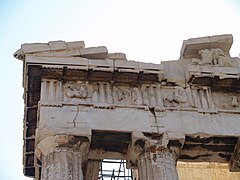
Метопы с запада с I по IV.
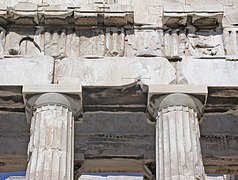
Метопы западные VI, VII, VIII и IX.

Метопы западные XIII и XIV.
Северные метопы

Тринадцать из тридцати двух северных метопов [N 9] пережил взрыв 1687 года, но уже сильно пострадал от уничтожения христиан. Девятнадцать других исчезли, но найденные фрагменты позволяют нам делать предположения об их пейзаже.[66][68] Шесть все еще находятся на месте в здании. Из-за их сохранности долгое время было трудно определить их тему. Адольф Михаэлис, во второй половине девятнадцатого века предположил, что воином справа от севера XXIV мог быть Менелай, преследующий Елену, изображенную на севере XXV. На последнем, помимо Хелен справа, он идентифицировал как Афродита фигура слева, две женские фигуры в обрамлении Эрос в полете слева и статуя Афины справа. Он основывал свою интерпретацию на двух текстах седьмого века до нашей эры. Мешок Трои Арктинос Милетский и Маленькая Илиада из Lesches Пирры. Эта гипотеза Михаэлиса предполагает, что темой метопов на северной стороне может быть захват Трои, даже если эта тема не затронута статуей Афины Парфенос.[69] Однако падение Трои могло стать логическим продолжением Амазономахии на западных метопах. Посетитель Акрополя идет по Парфенону с северной стороны наиболее очевидным и легким путем (в других местах Панафин). Тогда две битвы будут символически связаны с мифологическим напоминанием о том, что амазонки выбрали троянский лагерь. Более того, размещение этого ночного эпизода на северном фасаде было сделано для того, чтобы сыграть на дневном свете, который касается этих метопов, что редко зависит от времени года. Тогда возникнет символическая безвестность.[70]
Падение Трои было темой двух фресок Полигнота, которые могли послужить источником вдохновения для скульпторов метопов: одна была изображена в Стоа Пойкиле а другой был в Леше из Книдианов в Delphi.[71][72] В последнем числе персонажей, упомянутых Павсанием,[N 10] шестьдесят четыре, соответствует тому, что можно было найти на тридцати двух метопах с двумя цифрами по метопам.[71]
Достоверно очень мало описаний и отождествлений. Если все эксперты принимают определения Менелая (к северу от XXIV), Елены (к северу от XXV) и Селены (к северу от XXIX), тогда мнения по другим метопам расходятся, и все остается предметом интенсивных споров. Первым предметом разногласий является корабль North II. Хотя все согласны с тем, что это корабль, остается нерешенным один вопрос: спускается ли он с берега или швартуется? На самом деле все зависит от «читательского мастерства» этих метопов. Если их читать слева направо, с востока на запад (с севера на север, XXXII), то они рассказывают о прибытии греков и взятии Трои. Если их читать в том смысле, что посетители Акрополя читают их вдоль Парфенона с Пропилеи с запада на восток (с севера XXXII на север I), затем они рассказывают о падении Трои и уходе греков.[71][73]
Точно так же интерпретации не согласуются ни с одним эпизодом, описанным в гипотезе, где север II представляет прибытие греков в Трою. Метопы к северу I, II, III и A могут представлять прибытие греков ночью,[74][75] или приход Филоктета,[76][77][78] или прибытие Мирмидоны (согласно Илиаде, 19, 349-424).[79][80] Северные метопы с XXX по XXXII могли рассказать о последней встрече богов о падении Трои на горе Ида. [76][77][78][81][82] или назначить богов зрителями взятия Трои,[74] или встреча Зевса и Фетиды на Олимпе[75][80] или даже рождение Пандоры (в описании, данном Гесиодом в его Теогонии, 570-584 и Работы и дни, 54-82).[79]
Метопа Север I представляет слева сильно поврежденную человеческую фигуру: осталась нижняя часть пеплоса; ноги отсутствуют, а туловище сильно повреждено. У колен видна колесница. Справа хорошо видно тело лошади без головы. Две его левые ноги все еще находятся внизу метопа.[83] Он соответствует метопу XIV востока, на котором стоит другая колесница, а в конце восточного фронтона - колесница Селены.[84][26] С другой стороны, божество на колеснице на севере I идентифицируется по-разному. Чаще всего его видят сторонники рассказа о приходе ахейцев в Трою. Nyx[76][77][75][80] но также Эос,[77][78] иногда Селена[76] или же Афина.[79] Все сторонники отхода от греков видят Гелиос,[63][82][81][68][71] с тенью Hemera.[82]
На северном метопе II не видно ничего, кроме следов ног двух персонажей и фрагмента мрамора, указывающего на их торсы. Между двумя фигурами по диагонали угадываются лук и руль направления.[85] Тогда толкования меняются: прибытие греков в Трою. [76][77][78] возвращение Ахейцы после их фальстарта и их сокрытия за Tenedos прибытие мирмидонцев [79][80] отъезд греков.[63][82][81]

Примерно в таком же состоянии находится Северная Метопа III. Угадываем две фигуры: следы бюста и руку персонажа в хитон в профиль слева; бюст и круглый щит для персонажа лицом вправо и обнаженной.[86] Если все согласны с тем, что это солдаты, идентификация различается: Филоктет и гоплит;[76] Филоктет и Неоптолем;[77] Филоктет без обозначения второй фигуры;[78] Ахиллес или Неоптолем без идентификации второй фигуры;[79] взяться за оружие;[74] Улисс и Диомед если учесть, что Metopes North III и IV являются историей вторжения Долон в ахейском стане;[80] разоружение греков перед возвращением на борт.[63][82]

Из следующих метопов остались только более или менее важные фрагменты, самые крупные из которых обозначены буквами, обозначающими «квази» -метоп. Таким образом, метоп, обозначенный буквой «A» (потенциально север V), представляет собой поднимающуюся лошадь на заднем плане с фигурой человека, у которой только туловище и бедра остаются на переднем плане. Поэтому его иногда путали с южным метопом, принадлежащим циклу Кентавромахии. Эрнст Бергер, в своем синтезе метопов Парфенона 78 после большого симпозиума 1984 г. [N 11] суммирует для всех этих метопов различные гипотезы, предложенные на основе множественных интерпретаций фрагментов. Эпизод с троянским конем, конечно, не мог быть представлен из-за нехватки места на метопе. Для Metopes North IV - North VIII: Лаокоон и Палладий Бегство или сцена жертвоприношения и советы греков перед их отъездом. С севера IX по север XII: вокруг Ахиллес 'гробница с севера IX Труа или в другом месте; в Северной X Поликсен и Акамас или же Талтибиос север XI Брисеида и Агамемнон или же Феникс на севере XII Филоктет и убитый им троянский герой (названный Адметом или Диопейтом по версиям рассказа). Метопы с севера XIII на север XVI будут разворачиваться вокруг статуи Афины с севером XIII Кореба и Диомеда; на севере XIV святотатство Аякс (Кассандра и Ajax); в Севере XV Троенн и Севере XVI Гекуба. Те, кто с севера XVII по север XX развернутся вокруг алтаря Зевса, на севере XVII погибнет Приам на севере XVIII Astyanax и Неоптолем in north XIX Andromache and Polites; in north XX Agenor and Lycomede or Elephenor. The following metopes would have for general theme the goddess Aphrodite with in northern XXI DEiphobe and Teucros; in the north XXII Clymene (one of Helena's maids) and Menestheus or Acamas; in North XXIII (or metope designated by the letter "D") liberation of Ethra, with Éthra and Demophon and the "reunion" between Meneleas and Helen in North XXIV and XXV114.[87]
The north metope XXIII is most often identified with the metope designated by the letter "D". Two figures face each other. On the left, the bust (damaged), the hips and the upper thighs of a man are visible. He is naked, with a carved cloak on the bottom of the metope. He may have held a spear in his right hand. His left arm is stretched out to the right arm of the female figure on the right, who wears a peplos and has often been identified with Ethra, the mother of Theseus slave of Helen and released by Demophon son of Theseus (or his brother Acamas son of Theseus).[88][63][82][78] It is also the means to insist in the setting of the Parthenon on a purely Athenian episode of the Trojan War.[89] Another identification proposes Polyxene and Acamas[76] or Polyxene and anonymous Greek.[74][79][80]

Metopes North XXIV and XXV form an ensemble.[71] On Metope North XXIV, two male profile figures walk to the right. There remains only the trunk and the upper thigh of the left warrior, naked with a cloak. Of the one on the right, also naked, there remain only the trunk and the left forearm with a shield.[90] Menelaus (the identification accepted by all since Michaelis[91]) advances towards the next metope from which it is separated by the triglyph. The transition marked by this purely architectural element is also a sign of the passage from outside to inside .[92] The female figure to the left of North XXV was identified with Aphrodite by the Eros over her left shoulder. She wears a chiton and a himation. The following female figure is in peplos. She is veiled. She seems to run to the statue on the right to take refuge under her protection. Indeed, Menelaus pursued his wife to kill her, considering her responsible for the war and the death of his friends. This incident represented is the moment when Aphrodite will use his power to save his protege. She is about to open her himation to reveal her charms and her divine power. In parallel, Eros flies to Menelaus with either a phiale or a crown. The combined power of love and beauty will change the mind of Menelaus who will put down his sword and forgive his wife. This theme is very present in ceramics.[93][92] The identification of the divinity completely to the right beside the statue from which Helene comes to take refuge is more difficult. An oinochoe preserved in the Vatican Museum (Etruscan Gregorian Museum) and attributed to the Painter of Heimarmene [N 12] proposes an equivalent scene. On this one, Helene seeks the protection of an Athena in arms. The choice of this tutelary deity of Athens could make sense on this civic building. In addition, Athens was one of the cities claiming to have inherited the Palladium after the fall of Troy.[94][95]
Metope North XXVI is totally unknown.[96] On the north XXVII, there are two profile figures: a female, without a head, probably in peplos on the left and a male, naked with a chlamys, of which there remains only the bust, on the right. The characters walk and look to the right. The man may have carried a petasus, perhaps a shield. He may also have held the woman by the hand.[97] The theme of this metope may remain related to Aphrodite, like the previous ones. Some interpretations propose here the issue of Ethra by her grandchildren,[98][80] or a scene with Polyxena or a Trojan captive.[74] It could also be the priestess of Athena, Theano. Фреска Полигнотус in the Lesche of the Knidians represented her holding two of her sons by the hand, accompanied by Antenor holding one of her daughters. It could be here this family, before the Anchises family on the next metope. If this north metope XXVIII (towards which the characters walk) was the flight of Aeneas, then the female figure of north XXVII could also be Creusa.[99]
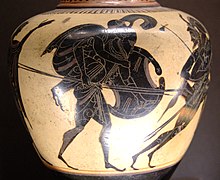
Metope North XXVIII is one of the most "charged", with no less than four characters. To the far left, in the foreground, is a motionless figure from the front, probably a woman: only her (missing) feet protruded from her long mantle. It is impossible to determine the gesture of his arms. At his immediate right and a little behind, another figure, considered an old man, is in profile turned to the male figure on his right. He wears a short-sleeved garment and a coat that leaves his right shoulder unobstructed. His two hands are resting on the shoulders of the next figure on the right. This is a naked man in a coat that goes down his back and between the legs. In the left arm, he carries a large round shield that protrudes above his head. The man walks to the right. In front of him, a last figure, probably male, smaller, in a coat. The most common interpretation for the three male figures is Anchises on the shoulders of his son Aeneas, himself preceded by his own son Ascagne. The female figure is therefore most often considered as Aphrodite (general theme of this series of metopes, but also mother of Aeneas). Sometimes she is identified as Cretace, the wife of Aeneas.[100]
A rider can be discerned on the Metope North XXIX, also marked by a decoration of rocks. The horse, perhaps a mare, is turned to the right, head down. The rider, rather a rider, seems to ride "amazon"?, the left arm resting on the neck of the mare. The rider is facing to the right. She has to wear a chiton. His right hand was to hold his veil. In the upper right corner is a slightly curved relief fragment, interpreted as a crescent moon. The rider would then be Selene. However, as it is not represented on horseback, it could also be the Pleiade Electre.[101]
There is almost nothing left of the metope north XXX, except on the bottom two traces of busts, perhaps two male figures. If we consider their location, between a celestial deity in North XXIX and Zeus and Hera in North XXXI and XXXII, then it could be gods, perhaps Apollo and Ares or Hermes; the three were, in effect, absent until then metopes north. Metope North XXXI is better preserved. The figure on the left is a man in a nude profile in a long coat?, sitting on a rock, an elbow resting on a thigh. The figure on the right is more in the foreground, from the front. It is thin with very visible wings down to the ground. The two figures are identified, in connection with the next metope, to Zeus and Iris, sometimes Eris or Nike.[102]
The only well preserved, and still in situ, metope on this north side is North XXXII. In 1933, Gerhart Rodenwaldt suggested [N 13] that it could have been read by Christians as an Annunciation and thus preserved while its position in the northwest made it very visible.[103] Two female figures face each other. One on the right is seated and the other on the left is walking towards her.[103][104] The female figure on the left wears an "Attic" peplos and makes the gesture of removing her cloak, with the left arm above the head and right along the thigh: the movement of the garment is very well made. It is found on a depiction of Apollo on a white-tailed skyphos preserved at the Boston Museum of Fine Arts.[N 14] The seated figure is in chiton, covered with a long mantle, which allows a work of sculpture on the drapes bunk. The right elbow is supported on the right knee; the legs are shifted: the left lower than the right. The left hand (disappeared, like the whole arm) was leaning behind, on the rock, placing the figure of three-quarters. It is possible that the left arm was added after carving, as suggested by the fixation hole.[104]
The most common interpretation for this Metope North XXXII is that to the left is Athena[105][106][107][26] and to the right of Hera [105][106][76][78][63] or sometimes Themis,[75][80] Aphrodite,[63][82] Cybele,[82] or even another unidentified female deity.[82][81] Kristian Jeppesen in 1963 suggests that it could be Pandora on the left and Aphrodite on the right.[79] Katherine A. Schwab disputes in an article of 2005 [106] the identification of Athena on the left. One of the main arguments in favour of Athena is that she is not or perhaps not identified elsewhere on this side unless, according to K. Schwab, she is on the metope North I, aboard the chariot. Indeed, this one seems to be braking, it can not be the chariot of one of the two stars. The second argument in favour of an identification of Athena is that she would carry the aegis on the chest. The counter-argument of K. A. Schwab is that what is interpreted as the aegis would in fact be a very damaged place of the metope. Finally, for K. Schwab, in her movement, her peplos open and revealing her bare leg, something impossible for a virgin goddess like Athena. It could then be Hebe, from the moment she is put in relation with the seated female figure?. This one is considered as Aphrodite or Hera. However, as Aphrodite is prominently on north XXV, she can not be as far north as XXXII. Moreover, on north XXXI, the male figure sitting would be Zeus. Therefore, in North XXXII, could be Hera, in a symbolic hierogamy. The winged figure next to Zeus in northern XXXI would be Iris, so the female figure walking north XXXII would be Hebe. The latter being linked to marriage and renewal, these two North Metopes XXXI and XXXII could mean the renewal of their vows by the divine couple Zeus-Hera, just as the marriage Menelaus-Helen is renewed in the North XXIV and XXV.[103]
East metopes

Since these metopes have been almost completely destroyed by Christians, it is difficult to know what they represented. However, in the nineteenth century, Adolf Michaelis[98] suggested that the character on east II could be a Dionysus (identified thanks to the panther and snake that accompany him) attacking a giant on the run. Michaelis then made the hypothesis that the metopes on this facade could represent Gigantomachy. Therefore, the identification of other figures was possible, even if some are still debated. The work was done by comparison with other representations of gigantomachy: Athenian vases of the fifth century BC., the Сифнийское казначейство или Пергамский алтарь However, these metopes were a turning point in the representation of the giants. Until the middle of the fifth century BC, they were represented as hoplites. Here, and in later representations, as in Pergamum, they are naked or simply dressed in animal skins.[108][16][26][109]
The figures of the metopes east V, VII, X and XIV are not opposed to a giant, but stand in a chariot. For this reason, they are sometimes identified not with a deity but with the charioteer of the chariot of divinity. The vehicle is turned towards the center of the facade.[109] The east metopes are organized symmetrically around a central axis, the same as for the eastern frieze and the as with the east pediment; moreover, the identifications are sometimes made by comparison with the divinities present in parallel on these two other decorative elements of the Parthenon. The four central metopes (east VI, VII, VIII and IX) are framed by two metopes with a chariot (east V and X) then the two metopes with three characters (east IV and XI). This composition would evoke the end of the fight and the imminent victory of the Olympians; the place of the confrontation would no longer be the plain of Phlegra but already the slopes of Olympus.[110][111]
| Метопа | В соответствии с (Michaelis 1871 ) | В соответствии с (Petersen 1873 ) | В соответствии с (Robert 1884 ) | В соответствии с (Studniczka 1912 ) | В соответствии с (Praschniker 1928 ) | В соответствии с (Brommer 1967 ) | В соответствии с (Tiverios 1982 ) | В соответствии с (Schwab 2005 ) |
|---|---|---|---|---|---|---|---|---|
| East I | ? | Гермес или же Арес | Гермес | Гермес | Гермес | Гермес | Гермес | Гермес |
| East II | Дионис | Дионис | Дионис | Дионис | Дионис | Дионис | Дионис | Дионис |
| East III | Арес | Посейдон | Арес | Арес | Арес | Арес | Гефест | Арес |
| East IV | Гера, Деметра или же Артемида | Афина | Гера | Athena and Nike | Athena and Nike | Athena and Nike | Athena and Nike | Athena and Nike |
| East V | Figure on a chariot | Nike driving the chariot of Athena presents on the previous metope. | Ирис or Nike leading Zeus' chariot present on the next metope. | Амфитрит | Амфитрит | Деметра | Амфитрит | Амфитрит |
| East VI | Посейдон | Геракл | Зевс | Посейдон | Посейдон | Male god | Poseidon and Полиботы | Посейдон |
| East VII | ? | Iris driving the chariot of Zeus present on the next metope. | Аглаурус driving the chariot of Athena present on the next metope. | Гера | Гера | Гера | Гера | Гера |
| East VIII | ? | Зевс | Афина | Зевс | Зевс | Зевс | Зевс | Зевс |
| East IX | Аполлон ? | Гера | Геракл | Аполлон | Аполлон | Геракл | Аполлон | Аполлон |
| East X | Artemis ? | Лето driving the chariot of Apollo present on the next metope. | Иолаос (?) leading the chariot of Heracles present on the next metope. | Афродита | Артемида | Афродита | Артемида | Артемида |
| East XI | ? | Аполлон | Аполлон | Эрос | Heracles and Eros | Apollo and Eros | Ares and Eros | Heracles and Eros |
| East XII | Demeter or Artemis | Артемида | Артемида | Артемида | Афродита | Артемида | Афродита | Афродита |
| East XIII | ? | Арес | Посейдон | Гефест | Гефест | Гефест | Геракл | Гефест |
| East XIV | ? | Nyx | Amphitrie | Sun god or sea god | Гелиос | Посейдон | Гелиос | Гелиос |
Two male figures are on the metope east I. The one on the left carries a chlamys; with her right hand, she seems to hold the right figure with her knees on the ground. With her left hand, she is about to strike a fatal blow. His sword was, given the fixing hole, to be a bronze object. The figure on the right bears a skin of animal and has the right hand resting on the hip of his adversary, perhaps to ask for grace. Thus Hermes is represented on the amphora of the Гигантомахия художника Суэсулы conserved in the Louvre.[N 15] Moreover, on the frieze of the Parthenon, on the east side, it is Hermes which is also completely on the left. On the metope east II, the divine figure of Dionysus is quite easily identifiable. In the foreground, an animal leaps between the figure on the left that is attacking and the one on the right that is leaking. The hind legs of the animal are feline legs. Fixing holes could also mean the presence of a bronze snake. Moreover, on the Parthenon frieze, on the east side, Dionysus is immediately to the right of Hermes. Finally, it is also on the left side of the eastern pediment. On the metope east III, very damaged, is guessed a round shield, between two figures of which there are only a few traces. The shield deity is most often identified with Ares: it is the third male deity on the east side of the frieze and is present on the left side of the eastern pediment.[114]
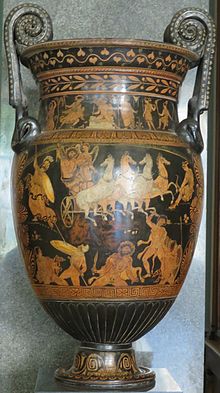
The general shape of the characters on east IV is still discernible. It has three figures. On the left, a fallen figure protects himself with his shield from the attack of a female figure. Behind it, to the far right is a smaller figure in flight. It seems that Athena is the central figure; she would walk to the left, her left arm protected from her shield with the aegis. In the right hand, she would hold a spear (added bronze object) which she would hit a giant, already on the ground and protecting himself with his own shield. At the top right, there is the little figure of Nike crowning the goddess. An equivalent composition is visible on the amphora attributed to the painter of Suessula preserved in the Louvre.[30][115] The Athena crowned by Nike is the sign of the upcoming victory of the gods, but also a tribute and a glorification of the city of Athens and its citizens, as on the entire building.[116]

On the metope east V can be seen a chariot, turned to the right and pulled by two horses. The two main interpretations are Demeter or Amphitrite. It is the latter that is most often suggested since it is considered that Poseidon appears on the next metope 144. The essential element of the metope east VI is a huge rock, both landscape element and weapon used by Poseidon against a giant: it would be the episode taking place between the god and Polybotes, in which the rock ripped off. on the island of Cos would have given birth to the new island of Nisyros?. The outlines of the characters are barely discernible. The giant would protect himself from his shield while Poseidon would crush his head with Nisyros. The composition is reminiscent of a crater fragment preserved in Ferrara.[N 16] and attributed to the Pélée painter who was inspired by the metope, as well as an attic bas-relief from the fourth century BC. now at the Metropolitan Museum of Art,[N 17][117][118]
The metope east VII again represents a chariot, pulled by two winged horses. The most common interpretation is Hera, since Zeus is identified on the next metope. Moreover, the divine couple is represented together in the centre of the frieze as well as the pediment. The metope is VIII is extremely damaged: a bust is guessed on the left and a shield is discerned in the upper right quarter. The bottom of a chiton is engraved on the bottom of the metope under the bust. The identification of Zeus is justified by the central place of the metope on the east facade. At the same time, the god is also in the centre of the frieze and pediment.[119] On the metope east IX, the figure on the left is probably a giant, holding in his right hand a club or a bronze torch (added given the hole of fixation). His right arm is protected from an animal skin. His opponent enters his right knee in the thigh?. The position of the god's right arm, which would hold a sword, is not unlike that of Harmodios in the group of Tyrannicides. The identification of Apollo is again related to the frieze and pediment where the god is on the right side.[120] The metope east X again shows a chariot pulled by two horses. On the frieze, the neighbours of Apollo are Artemis and Aphrodite, the two main propositions for the charioteer of this chariot. If one is identified as X, then the other is suggested for east XII, and vice versa. On the metope east XII, a female figure on the left walks to the right. She wears a peplos and her coat hangs from her left arm. There is too little of the giant (bust and head fragment) to determine anything. Here again, Artemis and Aphrodite are proposed, without being able to decide, especially since Eros is identified on the metope east XI, between the two. Finally, these two goddesses are sitting next to Apollo on the frieze. If Artemis is immediately on the right of his brother, Eros is also on the right of his mother, thus depriving us of a decisive rubric.[121]
The other metope with three characters is located in XI.[122] On the right, a giant fell to his knees. The central figure was so high in relief that it disappeared. The identification of this central character is still debated. On the left is a smaller figure (a youth?). The fixing holes on his shoulder and hip are reminiscent of the presence of a quiver, which would identify him as Eros. His presence is linked to that of Aphrodite (on the previous metope or the next). Tiverios[123] then makes the link Eros-Aphrodite to propose Ares as identification of the central figure. Another identification proposed is Apollo, in connection with IX: if Heracles is present in IX, then Apollo is on XI, and vice versa.[124] Indeed, Heracles is also suggested: he is regularly associated with Eros which he was the "pedagogue". Another argument is the symmetry between this metope and the metope is IV. If Athena is present in is IV, then her protege Heracles is certainly in is XI.[122][125] There remains almost nothing of the metope is XIII: on the left a shoulder, a bust and the hips of a figure visibly fallen to the ground; on the right one shoulder, the bust and the traces of one thigh and one leg of a figure dominating the other, probably preparing to crush it with a rock. It is most often Héphaïstos that is proposed.[126]
Two horses leap diagonally from right to left on the metope east XIV. In the bottom right corner, next to a calf, a fish is very clearly visible, hence the suggestion that sometimes the god of the chariot would be Poseidon.[127] However, Helios is a more common proposition. According to the account of Pseudo-Apollodorus,[N 18] Zeus stopped the march of the Sun and the Moon to allow Athena to go to Heracles to Hades, the presence of the hero being necessary for the victory. This episode would be according to Katherine A. Schwab in east IV and east XI, the only metopes with three characters and not two. East XIV, with the chariot of Helios coming out of the ocean, would be the expression of the resumption of the march of time.[30][128] Moreover, it responds to the metope north I, on which is represented a chariot, perhaps that of Athena, and at the end of the eastern pediment with the chariot of Selene.[129][16]
South metopes

On this side of the Parthenon, the preserved metopes represent the fight of the Centaurs and Lapiths[N 19] probably at the time of the marriage of the king of Thessaly Pirithoos with Hippodamia. Centaurs and Lapiths are cousins (Lapiths and Centaurs were half-brothers, sons of Apollo), hence the invitation of the Centaurs who descended from Pelion for the occasion. The effects of alcohol being felt, the Centaurs attacked the women and young men present. The Lapiths came to their aid, seizing all that was within their reach could serve as weapons, and the fight took such proportions that it continued outside. It is the fact that women are present in this centauromachy (as also on the west pediment of the temple of Zeus in Olympia) that identifies this specific episode, although it seems that some guests came with their shield, even throw them at the wedding.[130][131] The presence of this theme on an Athenian building celebrating the city is however not surprising: Theseus was the best friend of Pirithoos and was present at the ceremony and during the fight. According to Pausanias, a fresco by Mikon, in the hero of Theseus (not yet found), dating back to around 470 BC., already evoked this episode. This fresco greatly influenced the painters on vases, and certainly the sculptors of the metopes of the Parthenon.[132] Unlike the other sides, the Centaurs are not barbarians: they are from the Greek world. In addition, the sculptors of metopes have renewed the way of representing them. They made sure to remove the strangeness of the double nature, as it had been the case until then. The animal and human parts are not autonomous, but are well connected and functional. This is therefore a fight between Greeks; between humans and centaurs who are also closer to the human than the monster. The metopes could be a metaphor for the conflicts that then pitted the Greeks against each other.[133] This theme of the centauromachy can be read at another level for Athenian citizens. The behavior of the centaurs who do not respect the sanctity of the wedding ceremony could echo the sacrilege of the Persians when they destroyed the shrines of the Acropolis.[134]
These metopes are both the best preserved and the most fully destroyed. The best preserved are those ends that were taken to London by Lord Elgin, which preserved them completely, in comparison with those of the other sides remained on the building. However, the central metopes (South XIII to XXI) have also completely disappeared in the explosion of the powder magazine in 1687. Only the drawings attributed to Jacques Carrey, dating from 1674, remain. On these drawings there is no Centaur, which leads to a problem of interpretation of the general theme on this side. Fragments found during recent excavations on the Acropolis illuminated a little more.[135][136][131]
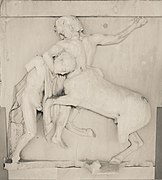
South I,
(in the Acropolis museum).
South I drawn in 1674.

South II.
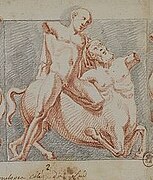
South II drawn in 1674.

South III.
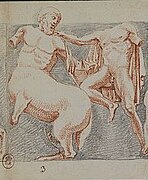
South III drawn in 1674.

South IV, with the heads restored.

South IV drawn in 1674.
The metope south I was one of the last to be still in place on the Parthenon, in the southwest corner, it was removed in 2013 and it is now in the Acropolis museum, it was replaced by a copy on site. A rearing Centaur, on the right, strangles with his left arm a Lapith in a mantle, on the left. He is about to deliver a fatal blow to his human adversary with an object held in his right hand, perhaps a tree trunk that would have been painted on the bottom of the metope. The right arm of Lapith has disappeared. However, a hole in Centaur's groin could give indications. The Lapithe would be piercing his opponent with a long metal object: lance or spit roasting. If it is a spear and we accept the hypothesis of the tree trunk, then this metope would be proof that the fight has moved outside.[137][24][138] The next metope (south II) has a reverse setting. A Centaur, in the background, has the knees of the front legs on the ground while a Lapith, in the foreground, strangles her left arm while pushing her left knee in the back.[139] On the southern metope III, a Lapith in a mantle, on the right, attacks a Centaur from behind. He jumps on his back and takes it to his throat. The belts and sheath of Lapithe were to be in bronze: the fixing holes are still visible.[12][140]
On the southern metope IV, a Centaur, on the right, is about to trample on a Lapith fallen to the ground on the left. This one protects itself from a shield (the only armour element of the set of South metopes preserved). The Centaur takes the opportunity to try to knock him out with a hydria. This one is used to determine the chronology of the events told by the metopes south: one would still be in the room of the banquet. The South IV Metope is at the British Museum. The heads were removed in 1688 by a Dane in the service of Francesco Morosini and the Venetian army. They are kept at the National Museum of Denmark in Copenhagen. The drawing of 1674 attributed to Jacques Carrey shows that the members still existed then: the general composition is thus better known.[141][142]
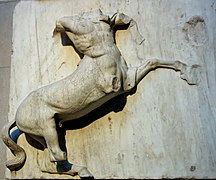
South V.
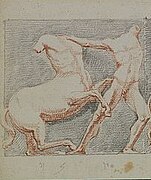
South V drawn in 1674.
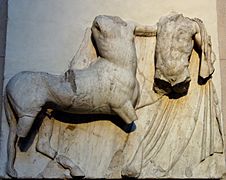
Métope sud VI.
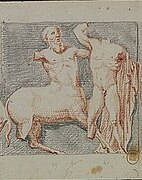
South VI drawn in 1674.
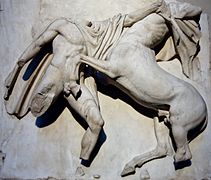
South VII.
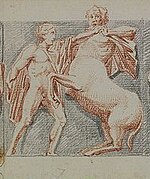
South VII drawn in 1674.
On the southern metope V remains only the Centaur, on the left, but the Lapith is known thanks to the drawing attributed to Carrey (the heads had already disappeared by then). The centaur is pitched up and has grabbed the Lapith by the upper body: he pulls his opponent violently backwards, trying to flee.[143]
On the southern metope VI, an old man (apparent wrinkles, flaccid skin and drooping tail) Centaur, on the right is opposed to a young Lapith wearing a cloak. On the drawing attributed to Carrey, the Lapith gives a blow with the right fist to the Centaur. The composition is unimaginative. It seems that the sculptor has insisted more on the difference of age than on the action. The head of the Centaur, present on the drawing attributed to Carrey, has since disappeared. On the other hand, the head of Lapitha, in place in 1674, was found in 1913 near the Varvakeio therefore at the foot of the Acropolis. She is now at the Acropolis Museum of Athens, while the Metope is at the British Museum.[43][144]
On the metope south VII, with the left hand, a Lapith, sometimes identified with Pirithoos, on the left, diagonally assault, a punch in the face of a Centaur who rears himself under the effect of the blow and is pushed on the right edge of the metope; his head even protruded from the upper edge. In the right hand, the Lapith had to hold a sword (metal object disappeared since). The Centaur does not wear a skin like the others, but a kind of fluid tissue that flies behind his back. The metope is at the British Museum. The heads are kept separately: that of Lapith is in the Louvre; that of the Centaur at the Acropolis Museum.[43][145]
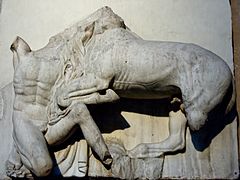
South VIII.
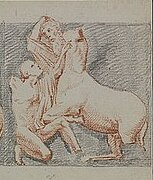
South VIII drawn in 1674.
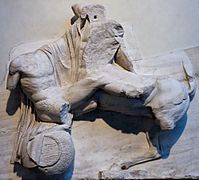
South IX

South IX drawn in 1674.
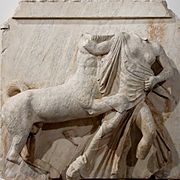
South X.

South X drawn in 1674.

South XI drawn in 1674.
The metope south VIII was badly damaged during the Parthenon explosion in 1687. On the left, a curled Lapith seeks to protect himself from the attack of the Centaur; he might even beg for mercy. The right arm of Lapith has completely disappeared and his gesture is unknown. He remains the Lapith's cloak, descending from his left shoulder to his thigh and the bottom of the beast's skin (perhaps of panther) which the Centaur wore on his right arm. The drawing attributed to Carrey shows that the Centaur had both arms raised; he might be wielding a tree trunk.[146][16][147] The abdominal muscles of Lapith are very well marked, but the style remains very fixed, not unlike the severe style of the early fifth century BC. As a result, the sculptor who made this metope might have been older or more conservative, or both, than his colleagues.[146]
The southern metope IX is preserved in the British Museum, but the heads of Lapith and Centaurs, which Carrey's drawing still shows, are preserved in the Acropolis Museum, as well as fragments of the shoulder and arms. The Centaur, on the right, with his left hand caught Lapithe's thigh, which he thus unbalanced. He's about to knock him out with something he's holding over his head. The Lapithe falls on a hydria or a dinos. He tries to recover by grabbing his opponent's hair with his left hand and placing the right (as Carrey's drawing shows) on the ground.[148]
The metope South X, considered as little successful, represents the cause of the fight: a woman carried away by a Centaur.[24] This one is bald if one believes the drawing attributed to Carrey. He squeezes Lapithe between the thighs of his front legs; the right leg lifting the woman's peplos. He also uses the left arm to grip it. In his right hand, he also holds the Lapith's right wrist (this movement is gone). She tries to flee, without success. In her desperate gesture, she discovers her left thigh and shoulder as well as her chest. The woman is sometimes identified with Hippodamia or her "maid of honor".[75][149] From the South XI metope remain only fragments and the drawing attributed to Carrey. On the latter, a Centaur to the left is pitched up and getting ready to hit a Lapith. This one, naked, wears only a cloak. In the right arm, he has a big round shield. He is sometimes identified with Theseus.[150]

South XII drawn in 1674.

South XIII drawn in 1674.

South XIV drawn in 1674.

South XV drawn in 1674.

South XVI.
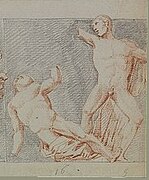
South XVI drawn in 1674.
The southern metope XII is also one of five where a Centaur attacks a Lapith. The woman, on the left, tries to free herself from the grip of the Centaur, but her feet already touch the ground only toes.[151][152] She is sometimes identified with Hippodamia, kidnapped by Eurytion. Indeed, the composition of the metope is inversely symmetrical with respect to the South X metope. The three southern metopes X, XI and XII are then sometimes read together: Centaur and Bridesmaid; Centaur and Theseus; Hippodamia and Eurytion.[75][153]

South XVII drawn in 1674.

South XVIII drawn in 1674.

South XIX drawn in 1674.
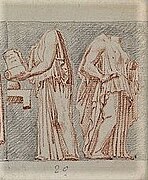
South XX drawn in 1674.
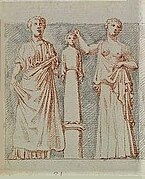
South XXI drawn in 1674.
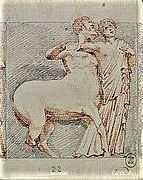
South XXII drawn in 1674.

South XXIII drawn in 1674.

South XXIV drawn in 1674.

South XXV drawn in 1674.
The following metopes, from south XIII to south XXV, are known only from the drawings attributed to Carrey. Some fragments have been found allowing reconstitution. As these metopes do not represent only Lapithe-Centaur duels, only present on south XXII to south XXV, various other interpretations have been proposed for metopes south XIII to XXI, sometimes without any connection with the episode of the marriage of Hippodamia and Pirithoos.[154] Erich Pernice and Frantz Studniczka read the myth of Erichthonios and the erection of the cult statue of Athena Polias. Charles Picard shares the opinion that this is the same myth of Erichthonios but he rather suggests the creation of Panathenae. Erika Simon sees the story of another Lapith, Ixion, the father of Pirithoos. Martin Robertson prefers the myth of Daedalus, with traveling geographical locations (South XIII to XVI in Athens, South XVII and XVIII in Knossos, return to Athens for South XIX to XXI).[155] Burkhard Fehr wants to read the opposition between the "good" wife Alceste (wife of Admetus) and the "bad" wife Phaedrus (wife of Theseus).[156] According to Hilda Westervelt[N 20] in her thesis defended at Harvard in 2004, this might not be a punctual event, but an account of the entire marriage of Hippodamia and Pirithoos. In the center is represented the moment when at the wedding the bride leaves the paternal house for that of her husband; the procession would then be disturbed by centaurs already drunk; the fight then extends to the outer metopes.[135]
| Метопа | South XIII Female figure (left) Male figure nude torso (right) | South XIV Male figure nude (left) Female figure carrying an object in each hand (right) | South XV A charioteer and his chariot | South XVI Two male nude figures The one on the left is on the ground | South XVII Male nude figure (left) Female figure carrying an object (right) | South XVIII Small human figure (left) Two female figures (courant ?) (center and right) | South XIX Two female figures | South XX Two female figures The one on the left seems to hold a roll of text | South XXI Two female figures framing a small statue on a pedestal |
|---|---|---|---|---|---|---|---|---|---|
| В соответствии с (Brøndsted & 1826-1830 ) revised by (Michaelis 1871 ) | Деметра и Триптолем | Эпиметей и Пандора | Erichthonios | Eumolpos или же Immaradus и Эрехтей | Erichthonios and a priestess of Athena or a канефор | One of the daughters of Цекропс I | Пандрос и Telete или же Фемида | Priestess or young woman carrying texts of laws | Parturient, cult statue of Artemis and priestess |
| В соответствии с (Pernice 1895 ) | Pandrosus and Herse | Эрисихтон и Аглаурус | Эрихтоний Афинский | Амфиктион and Erichthonius | Эрихтоний | ? | Жрица | Woman carrying ribbons to adorn the ксоанон of Athena Polias | Two women framing the ксоанон of Athena Polias |
| В соответствии с (Studniczka 1912 ) | Пифия и Ион | Xouthos и Creusa | Charioteer of the chariot of the right-hand figure on metope south XVI | Eumolpos или же Immaradus и Эрехтей | Herald and Citharede | Дочь Пракситея | Praxithea and one of her daughters chosen for sacrifice | Two women offering a sacrifice | Two women fleeing centaurs and taking refuge with the xoanon |
| В соответствии с (Picard 1936 ) | A daughter of Cecrops | Aglaure and one of his brothers | Discovery of the basket of Erichthonios | Астерион and Erichthonios | Erichthonios and a lyre player | Preparations for mysteries | Priestess and her assistant | Demonstration of a text roll and priestess | Back to the centauromachy; xoanon of Artemis |
| В соответствии с (Becatti 1951 ) | Pandrosus and Cecrops | Эрисихтон et Аглаурус | Charioteer of Erechtheus's chariot | Immaradus и Эрехтей | Erechtheus with a piglet offering and Аполлон | A daughter of Erechtheus | Praxithea and one of her daughters chosen for sacrifice | Procne и Филомела | Return to the centauromachy ; Софросинья и Hybris |
| В соответствии с (Fehl 1961 ) | Centauromachy; fright created by the arrival of a hero's chariot | Centauromachy; fright created by the arrival of a hero's chariot | Charioteer of the chariot of Геракл or of Theseus | Lapithe wounded by a Centaur and arrival of Hercules or Theseus | Centauromachy; двух девушек | Кентавромахия | Кентавромахия | Centauromachy; wedding ceremony of Гипподамия и Пиритоус | Two girls fleeing centaurs and taking refuge at a cult statue |
| В соответствии с (Jeppesen 1963 ) | Афродита и Butes[N 21] | Apollo and Creusa | Erichthonios and a racehorse | Эрикс defeated in boxing by Heracles | Erechtheus and Apollo | Хтония и ее сестры | Demeter and Персефона | Procne и Филомела | Two Lapiths fleeing centaurs and taking refuge at a cult statue |
| В соответствии с (Brommer 1967 ) | Pythia and Ion | Xouthos and Creusa | Metope linked to Erechtheus | Eumolpos или же Immaradus и Эрехтей | Player of an Aulos or carrier of wine and singer | Daughter of Erechtheus | Praxithea and one of her daughters chosen for sacrifice | Refusal of all the interpretations given so far, but no proposal for interpretation either for the metope or for the object carried by the woman on the left | Two women fleeing centaurs and taking refuge at a cult statue |
| В соответствии с (Simon 1975 ) | Nurse of Hippodamia and sommelier | Butes[N 22] and a young woman carrying offerings | Гелиос | Sacrilege of Иксион | Гермес with a piglet offering for the atonement of Ixion and Apollo by a Citharede | Little statue of divinity ; Aidos и Немезида fleeing the atrocity of Ixion | Нефеле и Peitho or Aphrodite | Apate или же Съел и Гера | Two women fleeing centaurs and taking refuge at a cult statue of Hera |
| В соответствии с (Dörig 1978 ) | Herse and Cecrops | Эрисихтон и Аглаурус | Борей удаление Orithyia | Erechtheus and Eumolpos | Procession to the cult statue present on the metope South XVIII during the Panathenaea | Statue of worship and two friends of Orithyia fleeing before Boreas after he removed it | Procne and Philomela | Zeuxippe и Хтония | Two young Lapiths fleeing centaurs and taking refuge at a cult statue |
| В соответствии с (Харрисон 1979 ) | Коронис, одна из медсестер Дионис and Dionysos | Coronis rapt by Butes | Гелиос | Sacrilege of Ixion | Pirithoos wedding: actor wearing a beast skin and lyre player | Pirithoos wedding: little girl and two dancers | Marriage of Pirithoos: mother and sister of the bride (Hippodamia) | Pirithoos' wedding: sister and mother of the fiancé (Pirithoos) | ? |
| В соответствии с (Fehr 1982 ) | Федра шпионаж Ипполит | Phaedra trying to seduce Hippolytus | Hippolytus going to his death | Асклепий убит Зевс | Hermes carrying a bottle of wine and Apollo singing | The Moires | Альцестида and a nurse | Preparation of the Alceste funeral bed: a nurse and Alcestis | Two women fleeing centaurs and taking refuge at a cult statue |
| В соответствии с (Robertson 1984 ) | In Athens : Perdix и Талос | In Athens : Дедал and a young girl wearing the invention of Talos | In Athens : Helios | In Athens : Икар and Dedalus | In Knossos : Daedalus and Theseus in chorus | In Knossos : Ариадна and two statues created by Daedalus dancing on the music of Theseus | In Athens after the return of Daedalus: discovery of the spinning wheel and weaving | In Athens after the return of Daedalus: discovery of the spinning wheel and weaving | Back to the centauromachy; worship statue of Athena |
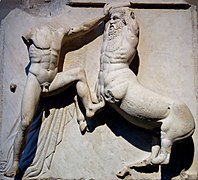
South sud XXVI.

South XXVI drawn in 1674.

South XXVII.
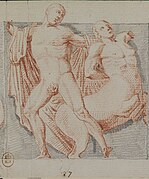
South XXVII drawn in 1674.

South XXVIII.

South XXVIII drawn in 1674.

South XXIX.
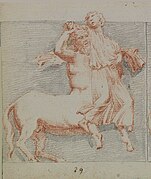
South XXIX drawn in 1674.
The metope south XXVI could have been sculpted by one of the least competent artists. Movements are unlikely; the face of the Centaur is frozen and the style of sculpture (severe) is old-fashioned for this second half of the fifth century BC.; the head of the Centaur is placed directly on the shoulders: he has no neck. Finally, a part of Lapith's garment drape did not hold and fell at a very old date.[157][16][158] The Lapith on the left gives a shot of his left foot in the chest of the Centaur; in his left hand he also grabs his right elbow. The Centaur seems to carry over the head a heavy object (block of stone or altar) that he is about to launch on his opponent. It seems that a well was present under the legs of the two characters. This element of scenery could mean (like the hypothetical tree trunk on South I) that the fight has moved outside.[158]
On the metope south XXVII, the Centaur, wounded, tries to flee at a gallop. He put his right hand on the wound he received in the back, unless he used both hands to try to extract the object that hurt him. The Lapithe, who could also be the hero Theseus,[82][159][75][160][161][33] tries to prevent him from fleeing, gripping his neck, with his left hand. His right hand is backward, catching up with a new blow, probably fatal with either a spear or a roasting spit. His coat is sliding from his shoulders to the ground. The faces of the two characters were turned towards the centre of the metope.[157][151][24][162] The heads have disappeared since the drawings attributed to Carrey. However, if the metope is in the British Museum, the Lapith's head is kept at the Acropolis Museum in Athens. This head is however also considered as being able to come from metope south IX. "Carrey" drew a beardless Centaur. Several hypotheses are then advanced: the designer would not have seen that the beard had been broken; the ancient sculptor created with this metope a new canon of representation of the Centaurs as much younger.[163] This metope south XXVII is considered one of the most successful. The rendering of the anatomy is perfect. The tension of the movement is visible in the sculpture of the muscles of Lapith's leg and torso. The drape, perfect, of the mantle is in such high relief that it is detached almost completely from the bottom. The tail of the Centaur is part of the continuity of one of the folds of the coat: it had to be painted in different colours to bring out. This movement of the mantle recalls that of figure M of the pediment of the Temple of Zeus at Olympia, traditionally identified with Theseus, hence the identification here. The composition is subtle: the two tensions in two opposite directions recall those characteristic of the central group of a pediment, similar to the movement that animates Athena and Poseidon on the west pediment. Finally, it also recalls the western metope IV of the temple of Zeus in Olympia (Heracles and the bull of Crete). We also find this motif on the neck of a volute krater attributed to the painter of the Woolly Satyrs and preserved in New York. If the sculptor is not known, he must however be one of the most gifted to have worked on the Parthenon.[164][165][16]
The southern metope XXVIII is by its style quite similar to its neighbour south XXVII. A Centaur rears over a Lapithe on the ground. On the left arm, he has a skin of animal, perhaps of panther, which he had to use to protect himself. In the right hand he holds a large vase. If the arm and the vase have disappeared, however, there remains a fragment above the Centaur's shoulder.[166][167] Martin Robertson suggests that the man the Centaur is about to kill could be Daedalus.[161][167] The metope south XXIX is one of the five preserved that does not represent the fight, but the cause of the fight: a bald Centaur takes a Lapith woman. He encloses her with his left arm. The drawing attributed to Carrey shows that he held his right wrist with his right hand.[166][167] The quality of the sculpture is very heterogeneous. The face of the Centaur is frozen and inexpressive; Lapith's position is improbable. В отличие от этого, драпировка хитона очень высокого качества, на уровне ириса западного фронтона; то же самое для границы мантии Кентавра, уровня того, что находится на фризе.[166][16][24]

Юг XXX.
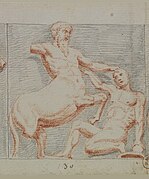
Юг XXX нарисован в 1674 году.

Юг XXXI.
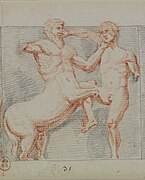
Юг XXXI нарисован в 1674 году.

Юг XXXII.

Юг XXXII нарисован в 1674 году.
На южном метопе XXX Лапиф справа стоит на коленях. Кентавр погружает копыта передних ног в бедра. Движение по-прежнему видно правым конечностям; левые конечности были сломаны.[168] Метоп южный XXXI также вырезан в несколько старом (суровом) стиле для второй половины V века до нашей эры.[166][16] Кентавр слева схватил Лапифа за горло. Между передними ногами он держит правую ногу своего противника, который входит ему в грудь в колено. Лапит пытается вытащить лохматые волосы Кентавра.[168] Позиции заморожены; анатомия не прорисована. Лицо Кентавра скорее гротескное, чем выразительное. Само качество работы оставляло желать лучшего: правая рука «Кентавра» сломалась в древности и была заменена новой, прикрепленной к щиколоткам.[166]
На южном метопе XXXII Лапиф справа решительно продвигается к Кентавру слева. Его ставят так, как будто он защищает себя. На рисунке, приписываемом Керри, правая рука Центавра и левая Лапит все еще присутствовали. Голова Лапита также существовала в 1674 году. Деталь на передней части дала возможность предположить, что Лапит мог носить коринфский шлем. Положение тела и рук Лапифа напоминает положение Хармодиоса из группы Тираннонос. К тому же этот метоп - последний в юго-восточном углу (возле священного фасада). Поэтому этого человека иногда называют Тесеем, основателем афинской демократии.[169][24]
Примечания
- ^ На щите: снаружи амазонки атакуют Акрополь; внутри - гигантомахия. На подошвах сандалий: битва кентавров и лапифов. (Шваб 2005, п. 167)
- ^ Гармония божественных пар, сражающихся бок о бок во время гигантомахии; контрпример того, что амазонки отказываются от обычной роли женщин; битва кентавров и лапифов на свадьбе Пирита; Троянская война, вызванная похищением Елены. (Шваб 2005, п. 168)
- ^ Это даже точно для юга V, XXVII, XXVIII и XIX. (Бергер 1986, п. 79)
- ^ Север: I, XXIX, XXXI и XXXII и восток: VI и VII.
- ^ Однако точная дата разрушения метопов неизвестна и поэтому не может быть контекстуализирована. Приписать этот акт византийскому иконоборчеству проблематично, поскольку фронтоны и боги на восточном фризе также не подвергались систематическому повреждению. Энтони Калделлис: Христианский Парфенон, классицизм и паломничество в византийских Афинах, Кембридж, 2009, стр.42.
- ^ Юг II, III, IV, V, VI, VII, VIII, IX, XXVI, XXVII, XXVIII, XXIX, XXX, XXXI и XXXII.
- ^ Это был термин, который использовал Фовель.
- ^ Национальный археологический музей Афин, NM 3708
- ^ Север с I по III, XXIII (или метоп, обозначенный буквой «D») до XXV, с XXVII по XXXII, также обозначенный буквой «A», который может быть V
- ^ 10.25-27
- ^ Бергер, Эрнст (1984). фон Заберн (ред.). Дер Парфенон-Конгресс Базель. Referate une Berichte 4. bis 8. Апрель 1982 г. (на немецком). ISBN 978-3-8053-0769-7..
- ^ Инв. 16535
- ^ «Интерпретация Кристиана», Archäologischer Anzeiger, 3/4, 1933.
- ^ Приписывается художнику из Карлсруэ, инв. 00-356.
- ^ С 1677.
- ^ Museo Nazionale di Spina, T. 3000 (инв. 2892)
- ^ Инв. 29,47
- ^ Bibliothèque, 1.6.1 à 1.6.3
- ^ Овидий, Метаморфозы, 12.210-535
- ^ Работа «Кентавромахия в греческой архитектурной скульптуре» вскоре будет опубликована в Кембридже.
- ^ Кристиан Джеппесен упоминает Бутса, сына Борея, отца Гипподамии (беря Диодора Сицилийского, IV, 70), но он настаивает на омонимии с аттическим героем Бутесом, сыном Пандиона, братом Эрехтея, даже с Бутом, сыном Телеона, любовником Афродиты и отец Эрикса, присутствовавший на южной вершине XVI. (Джеппесен 1963, п. 36).
- ^ Вероятно, Бутс сын Борея, отец Гипподамии.
Рекомендации
- ^ а б c d Хольцманн и Паскье 1998, п. 177.
- ^ а б Повар 1984, п. 8.
- ^ а б Нилс 2006, п. 11.
- ^ Повар 1984, стр. 8-10.
- ^ Нилс 2006, п. 24.
- ^ Нилс 2006, п. 27.
- ^ а б Нилс 2006, п. 28.
- ^ Нилс 2006, стр.29, 31.
- ^ Повар 1984, п. 12.
- ^ а б Шваб 2005, п. 159.
- ^ Бордман 1985 С. 60, 62.
- ^ а б Повар 1984, п. 19.
- ^ Повар 1984, п. 18.
- ^ Бордман 1985, п. 119.
- ^ Шваб 2005, п. 159, 161–162.
- ^ а б c d е ж грамм час я j k л Хольцманн и Паскье 1998, п. 179.
- ^ а б Бордман 1985, п. 103.
- ^ а б Бергер 1986, п. 8.
- ^ а б c d е ж грамм час я j Повар 1984, стр. 18-19.
- ^ а б Шваб 2005, п. 167.
- ^ Нилс 2005, п. 199.
- ^ а б Бордман 1985 С. 119-120.
- ^ а б Шваб 2005, п. 159, 167–168.
- ^ а б c d е ж грамм Бордман 1985, п. 105.
- ^ а б Шваб 2005, п. 168.
- ^ а б c d е ж грамм час я Бордман 1985, п. 104.
- ^ а б c d Бергер 1986 С. 8, 77.
- ^ а б Шваб 2005, п. 162.
- ^ Шваб 2005 С. 159, 162.
- ^ а б c Шваб 2005, п. 169.
- ^ Повар 1984, стр. 23-24.
- ^ Бордман 1985, п. 120.
- ^ а б Бергер 1986, п. 79.
- ^ Станье 1953, п. 73.
- ^ Шваб 2005 С. 160-161.
- ^ Остерхаут 2005, п. 298.
- ^ Остерхаут 2005 С. 298-305.
- ^ а б c d е Шваб 2005 С. 165-166.
- ^ Остерхаут 2005 С. 306-307.
- ^ Остерхаут 2005 С. 317-320.
- ^ а б Остерхаут 2005 С. 320-321.
- ^ Шваб 2005, п. 165.
- ^ а б c Повар 1984, п. 20.
- ^ Замбон 2007 С. 73, 75.
- ^ Бергер 1986, п. 86.
- ^ «Официальный сайт Британского музея». Получено 26 августа 2014..
- ^ а б Замбон 2007, п. 73.
- ^ Легран 1897, п. 198.
- ^ Сен-Клер 1983, п. 103.
- ^ Бордман 1985 С. 103-104.
- ^ Бергер 1986.
- ^ Бергер 1986, п. 100.
- ^ а б Шваб 2005 С. 178-179.
- ^ а б c d Бергер 1986, п. 99.
- ^ Шваб 2005, п. 179.
- ^ а б Шваб 2005 С. 179, 183.
- ^ а б Бергер 1986, п. 101.
- ^ Бибер 1968, п. 395.
- ^ Бергер 1986, п. 102-104, 106.
- ^ Шваб 2005 С. 179-182.
- ^ Бергер 1986, п. 102.
- ^ а б Бергер 1986, п. 103.
- ^ а б c d е ж грамм Пращникер 1928.
- ^ Бергер 1986, п. 104.
- ^ Бергер 1986, п. 105.
- ^ а б Шваб 2005, п. 183.
- ^ Бергер 1986 С. 106-107.
- ^ а б Бергер 1986, п. 11.
- ^ Шваб 2005 С. 183-184.
- ^ Шваб 2005 С. 188-189.
- ^ а б c d е Шваб 2005, п. 184.
- ^ Бергер 1986, п. 12.
- ^ Бергер 1986, п. 11, 14-17.
- ^ а б c d е Рас 1944.
- ^ а б c d е ж грамм Саймон 1975.
- ^ а б c d е ж грамм час Studniczka 1929.
- ^ а б c d е ж Швейцер 1940.
- ^ а б c d е ж грамм Бекатти 1951.
- ^ а б c d е ж грамм Джеппесен 1963.
- ^ а б c d е ж грамм час Дериг 1984.
- ^ а б c d Арии 1965.
- ^ а б c d е ж грамм час я j Пикард 1936.
- ^ Бергер 1986, п. 19.
- ^ Шваб 2005, п. 158.
- ^ Бергер 1986, п. 20.
- ^ Бергер 1986, п. 21.
- ^ Бергер 1986 С. 25-32.
- ^ Бергер 1986, п. 16, 36.
- ^ Бергер 1986, п. 36.
- ^ Бергер 1986, п. 37.
- ^ Бергер 1986, п. 16.
- ^ а б Шваб 2005 С. 184-185.
- ^ Бергер 1986, п. 38.
- ^ Бергер 1986 С. 38-39.
- ^ Шваб 2005 С. 185-186.
- ^ Бергер 1986, п. 39.
- ^ Бергер 1986, п. 40.
- ^ а б Михаэлис 1871.
- ^ Бергер 1986, п. 40-43.
- ^ Бергер 1986 С. 44-45.
- ^ Бергер 1986 С. 45-46.
- ^ Бергер 1986 С. 15, 46-48.
- ^ а б c Шваб 2005 С. 187-188.
- ^ а б Бергер 1986, п. 49.
- ^ а б Хольцманн и Паскье 1998, п. 178.
- ^ а б c Шваб 2005, п. 188.
- ^ Бергер 1986, п. 15.
- ^ Шваб 2005 С. 168-169.
- ^ а б Бергер 1986, п. 55.
- ^ Шваб 2005 С. 171-172.
- ^ Бергер 1986 С. 53-55.
- ^ Михаэлис 1871, п. 145-148.
- ^ Бергер 1986, п. 56-57.
- ^ Бергер 1986 С. 59-60.
- ^ Бергер 1986 С. 60-61.
- ^ Шваб 2005 С. 172-173.
- ^ Шваб 2005 С. 170-171.
- ^ Бергер 1986, п. 62.
- ^ Бергер 1986 С. 63-64.
- ^ Бергер 1986, п. 65.
- ^ Бергер 1986, п. 66, 68.
- ^ а б Шваб 2005, п. 170.
- ^ Тивериос 1982.
- ^ Бергер 1986 С. 66-67.
- ^ Бергер 1986 С. 67-68.
- ^ Бергер 1986, п. 69.
- ^ Бергер 1986, п. 71.
- ^ Бергер 1986 С. 71-76.
- ^ Шваб 2005, п. 158, 169.
- ^ Шваб 2005 С. 173-174.
- ^ а б Бергер 1986, п. 78.
- ^ Шваб 2005 С. 174-175.
- ^ Бергер 1986 С. 77-79.
- ^ Шваб 2005, п. 178.
- ^ а б Шваб 2005, п. 174.
- ^ Бордман 1985 С. 104-105.
- ^ Шваб 2005 С. 175-176.
- ^ Бергер 1986, п. 82.
- ^ Бергер 1986, п. 83.
- ^ Бергер 1986 С. 83-84.
- ^ Повар 1984 С. 19-20.
- ^ Бергер 1986, п. 84.
- ^ Бергер 1986, п. 85.
- ^ Бергер 1986 С. 85-86.
- ^ Бергер 1986 С. 86-87.
- ^ а б Повар 1984, п. 20, 22.
- ^ Бергер 1986, п. 87.
- ^ Бергер 1986, п. 88.
- ^ Бергер 1986, п. 79, 89.
- ^ Бергер 1986, п. 89.
- ^ а б Шваб 2005 С. 176-177.
- ^ Бергер 1986, п. 90.
- ^ Бергер 1986, п. 79, 90.
- ^ Бергер 1986, п. 91.
- ^ а б Бергер 1986 С. 92-93.
- ^ Фер 1982.
- ^ а б Повар 1984, п. 22.
- ^ а б Бергер 1986, п. 94.
- ^ Броммер 1967.
- ^ Дериг 1978.
- ^ а б Робертсон 1984.
- ^ Бергер 1986, п. 95.
- ^ Бергер 1986 С. 94-95.
- ^ Повар 1984, п. 22-23, 42.
- ^ Шваб 2005 С. 176-178.
- ^ а б c d е Повар 1984, п. 23.
- ^ а б c Бергер 1986, п. 96.
- ^ а б Бергер 1986, п. 97.
- ^ Бергер 1986, п. 98.
Библиография
- Паоло Энрико Ариас, Problemi di scultura greca, Болон, Casa Editrice Prof. Riccardo Patron, 1965.
- Джованни Бекатти, Problemi Fidiaci, Florence, Electa, 1951.
- Эрнст Бергер, Парфенон в Базеле: Dokumentation zu den Metopen, t. Textband, Mayence, Филипп фон Цаберн, 1986.
- Маргарет Бибер, «Рецензируемая работа: De Metopen des Parthenon. Katalog und Untersuchung Фрэнка Броммера », Американский журнал археологии, т. 72, № 42, октябрь 1968 г.
- Джон Бордман, Греческая скульптура: классический период, справочник, Лондон, Темза и Гудзон, 1985,
- Джон Бордман, греческое искусство, Лондон, Темза и Гудзон, 1985.
- Джон Бордман (трад. Флоренс Леви-Паолони), La Sculpture grecque classique [«Греческая скульптура: Классическая скульптура»], Париж, Темза и Гудзон, колл. «L'Univers de l'art», 1995 г.
- Франк Броммер, Die Metopen des Parthenon, Mayence, Филипп фон Заберн, 1967.
- Питер Олуф Бронстед, Voyages dans la Grèce, сопровождаемый археологическими исследованиями и suivis d'un aperçu sur toutes les entreprises scientifiques qui ont eu lieu en Grèce depuis Pausanias jusqu'à nos jours, Париж, Фирмин Дидо, 1826-1830 гг.
- Брайан Кук, The Elgin Marbles, Лондон, British Museum Publications Ltd, 1984,
- Хосе Дериг, «Traces des Thraces sur le Parthénon», Museum Helveticum. Revue Suisse pour l'étude de l'antiquité classique, Лозанна, 1978 г.
- Хосе Дериг, «Северные метопы Парфенона», в Э. Бергер, Der Parthenon-Kongress Basel. Referate une Berichte 4. bis 8. Апрель 1982 г., Mayence, von Zabern, 1984 г.
- Филипп Фель, «Скалы на фризе Парфенона», Журнал институтов Варбурга и Курто, вып. 24, № 1/2, январь – июнь 1961 г.
- Буркхард Фер, «Die« gute »und die« schlechte »Ehefrau: Alkestis und Phaidra auf den Südmetopen des Parthenon», Гефест. Kritische Zeitschrift zu Theorie und Praxis der Archäologie und angrenzender Gebiete, № 4, 1982.
- Эвелин Берд Харрисон, «Иконография одноименных героев на Парфеноне и в Агоре», в Отто Мёркхольме и Нэнси Вагонер (ред.), Греческая нумизматика и археология: очерки в честь Маргарет Томпсон, Ветерен, Numismatique romaine, 1979.
- Бернар Хольцманн и Ален Паскье, История античного искусства: Греческое искусство, Париж, Французская документация / Réunion des musées nationaux, колл. «Manuels de l'École du Louvre», 1998 г.,
- Кристиан Джеппесен, «Bild und Mythus an dem Parthenon», Acta Archaeologica, № 34, 1963.
- Филипп-Эрнест Легран, «Биография Луи-Франсуа-Себастьяна Фовеля, антиквара и консула (1753-1838) (сюита)», Revue Archéologique, 3esérie, no XXX, janvier-juin 1897
- Адольф Михаэлис, Парфенон, Лейпциг, Breitkopf und Härtel, 1871 г.
- Дженифер Нилс, «« С изображениями благородных людей со всех сторон »: Ионный фриз Парфенона», в Дженифер Нилс (ред.), Парфенон: от древности до наших дней, Кембридж, Cambridge University Press, 2005
- Дженифер Нилс, Фриз Парфенона, Кембридж, Cambridge University Press, 2006
- Роберт Остерхаут, «« Оседлайте самую вершину рая »: Парфенон после античности», в Дженифер Нилс (ред.), Парфенон: от античности до наших дней, Кембридж, Cambridge University Press, 2005
- Эрих Пернис, «Über di mittleren Methoden der Südseite des Parthenon», Jahrbuch des Deutschen Archäologischen Instituts, № 10, 1895.
- Евгений Петерсен, Die Kunst des Pheidias am Parthenon und zu Olympia, Берлин, Вайдман, 1873 г.
- Шарль Пикар, Греческая мануэль археологии: скульптура, тома I и II, Париж, А. Пикар, 1936 и 1939.
- Камилло Прашникер, Parthenonstudien, Аугсбург, доктор Б. Фильзер, 1928.
- Сюзанна Рас, «Dans quel sens faut-il regarder les métopes Nord du Parthénon? », Revue des Études Grecques, 57e série, № 269, 1944, с. 87-105
- Брунилда Риджуэй, Стили пятого века в греческой скульптуре, Принстон, 1981.
- Карл Роберт, «Die Ostmetopen des Parthenon», Archäologische Zeitung, № 42, 1884.
- Мартин Робертсон, «Южные метопы: Тесей и Дайдалос», в Э. Бергер, Der Parthenon-Kongress Basel. Referate une Berichte 4. bis 8. Апрель 1982 г., Mayence, von Zabern, 1984 г.
- Клод Ролли, Греческая скульптура, т. II: La période classique, Manuels d'art et d'archéologie antiques, Пикард, 1999.
- Уильям Сен-Клер, Лорд Элгин и мрамор, Оксфорд, Oxford University Press, 1983 (1-е изд. 1967),
- Кэтрин А. Шваб, «Торжества победы: Метопы Парфенона», в Дженифер Нилс (ред.), Парфенон: от древности до наших дней, Кембридж, Cambridge University Press, 2005
- Бернар Швейцер, «Pheidias der Parthenon-Meister», Jahrbuch des Deutschen Archäologischen Instituts, № LV, 1940.
- Эрика Симон, «Versuch einer Deutung der Südmetopen des Parthenon», Jahrbuch des Deutschen Archäologischen Instituts, № 90, 1975.
- Роберт Спенсер Станье, «Стоимость Парфенона», Journal of Hellenic Studies, vol. 73, 1953 г.
- Франц Студничка, «Neues über die Parthenonmetopen», Neue Jahrbücher für das klassische Altertum, Geschichte und Deutsche Literatur, № 29, 1912.
- Франц Студничка, «Neues über die Parthenonmetopen», Neue Jahrbücher für Wissenschaft und Jugendbildung, № 5, 1929.
- Михаэлис А. Тивериос, «Наблюдения за восточными метопами Парфенона», Американский журнал археологии, № 86, 1982.
- Алессия Замбон, «Луи-Франсуа-Себастьен Фовель и конституция коллекции Шуазель-Гуффье», данс Одиль Кавалье, «Путешествие Греса дю графа Шуазель-Гуффье», Ле Понте, А. Бартелеми, 2007























































